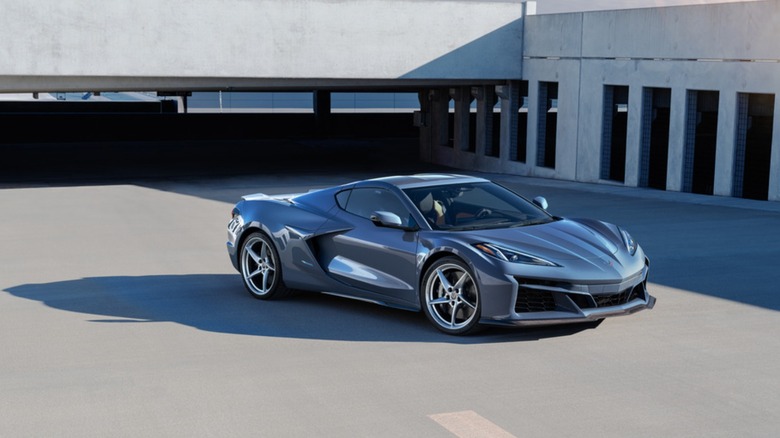The Corvette E-Ray And The Toyota Prius Have More In Common Than You'd Think
The Corvette has been a staple in the American motoring industry ever since its release 70 years ago, eventually becoming an icon of American performance motorsport.
Most recently, the 2019 mid-engine Corvette C8 garnered a lot of positive feedback from the motoring world thanks to an impressive powertrain, sporting design, and grippy handling. While the interior of the newest Corvette drew some criticisms for being decidedly basic and cramped, and the lack of safety features means that drivers need to be a little more careful, the Corvette embodies performance motoring at an aggressive price.
In recent years, though, performance and luxury motoring has looked a little different, with electric and hybrid-electric vehicles from the likes of BMW, Mercedes-Benz, Polestar, Porsche, and Tesla taking center stage in the automotive world. Electric motors provide several benefits over their gas-powered counterparts, including instant torque, lower maintenance, and better weight distribution. For the 70th anniversary of the Corvette, General Motors is joining the ranks of the electric performance hybrid by releasing the Corvette E-Ray, which surprisingly bears a lot of resemblance to what many would consider the antithesis of performance — the Toyota Prius.
A quick, hybrid-electric, AWD Corvette E-Ray
Announced on January 17, 2023, the world's first production hybrid Corvette features a hybrid-electric, all-wheel-drive system that sends power to all four wheels. In that aspect, the Corvette E-Ray is just like the 2023 Toyota Prius, but that's about where the similarities end. While both vehicles use the internal combustion engine and electric motors separately, the Corvette uses its 6.2-liter LT2 small block V-8 engine to power the rear wheels, and the Prius uses a blend of gas and electric motors to power the front and electric motors exclusively in the rear.
In the Corvette E-Ray, the electric motor powering the front axles delivers 160 horsepower and 125 foot-pounds of instant torque. Combined, the vehicle's maximum output is 655 horsepower, and delivering that through all four wheels means not only improved efficiency — thanks to regenerative braking and coasting — but also greater traction in adverse conditions and increased stability. Chevrolet claims the E-Ray can hit 60 mph from a standstill in a mere 2.5 seconds, and finish a quarter mile in 10.5 seconds at 130 mph.
The Corvette E-Ray is a mild hybrid, meaning there's no charging, although it does feature Stealth Mode which uses only the electric motors to drive the vehicle at speeds of up to 45 mph. The vehicle automatically re-engages the gas motor when the 1.9 kWh battery pack is depleted, or when the driver exceeds the 45 mph speed limit. While it may not be as particularly efficient as the Toyota Prius' fuel economy, the E-Ray's performance is vastly superior. The E-Ray will be available starting at $104,295 in 2023.
